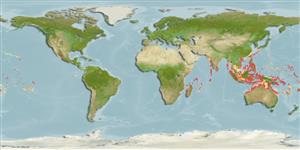Common names from other countries
>
Eupercaria/misc (Various families in series Eupercaria) >
Labridae (Wrasses) > Cheilininae
Etymology: Cirrhilabrus: Latin, cirrus = curl fringe + Greek, labros = furious (Ref. 45335).
More on author: Smith.
Environment: milieu / climate zone / depth range / distribution range
Ecología
marino asociado a arrecife; rango de profundidad 6 - 40 m (Ref. 48636), usually ? - 10 m (Ref. 5278). Tropical; 33°N - 24°S
Indo-Pacific: East Africa south to Sodwana Bay, South Africa (Ref. 4392) and east to the Tuamoto Islands.
Tamaño / Peso / Age
Maturity: Lm ? range ? - ? cm
Max length : 12.0 cm SL macho / no sexado; (Ref. 9823)
Short description
Claves de identificación | Morfología | Morfometría
Espinas dorsales (total) : 11; Radios blandos dorsales (total) : 8 - 9; Espinas anales: 3; Radios blandos anales: 9. Large oval black spot on caudal peduncle just above lateral line (Ref. 4392). A closely related undescribed species occurs in west and central Pacific; differs in color, greatest between nuptial males (Ref. 48636).
Occurs over rubble or low patch reefs in areas of current (Ref. 9823); also on reef edges and around bommies with rubble zones (Ref. 48636); often in moderately large groups and mixed sex during feeding on zooplankton well above the substrate. Males often display to each other (Ref. 48636). Reported to be associated with the mushroom coral Heliofungia actiniformis (Ref. 91291). Feeds on zooplankton in the water column (Ref. 9823).
Life cycle and mating behavior
Maturities | Reproducción | Spawnings | Egg(s) | Fecundities | Larva
Distinct pairing during breeding (Ref. 205).
Randall, J.E., 1992. A review of the labrid fishes of the genus Cirrhilabrus from Japan, Taiwan and the Mariana Islands, with descriptions of two new species. Micronesica 25(1):99-121. (Ref. 5278)
IUCN Red List Status (Ref. 130435)
CITES (Ref. 128078)
Not Evaluated
Threat to humans
Harmless
Human uses
Pesquerías: comercial; Acuario: Comercial
Herramientas
Special reports
Download XML
Fuentes de Internet
Estimates based on models
Preferred temperature (Ref.
115969): 26.3 - 29.3, mean 28.5 (based on 2345 cells).
Phylogenetic diversity index (Ref.
82804): PD
50 = 0.5000 [Uniqueness, from 0.5 = low to 2.0 = high].
Bayesian length-weight: a=0.01585 (0.00707 - 0.03555), b=2.95 (2.76 - 3.14), in cm Total Length, based on LWR estimates for this (Sub)family-body shape (Ref.
93245).
Nivel trófico (Ref.
69278): 3.4 ±0.45 se; based on food items.
Resiliencia (Ref.
120179): Alto, población duplicada en un tiempo mínimo inferior a 15 meses (Preliminary K or Fecundity.).
Fishing Vulnerability (Ref.
59153): Low vulnerability (10 of 100).
